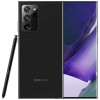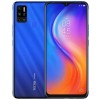Redmi is owned by the Chinese electronics company Xiaomi. It was first announced on a line of budget smartphones in July 2013 and in 2019 it became a separate Xiaomi sub-brand with entry-level and mid-range devices, and Xiaomi itself produces the best Mi phones. Redmi phones use Xiaomi MIUI user interface on Android. The models are categorized into Redmi (entry-level class), Redmi Note and Pro (mid-range) and Redmi A (lower class) and Redmi X (mid-range) and Redmi K (mid-range). And Redmi note series has become popular among the users.Note series come up with an affordable budget having a very good built in,camera & design.Today,I'm going to talk about recently launched note series smartphone named Redmi 9 pro.
Highlights-
> Xiaomi Redmi Note 9 Pro has a 6.67-inch screen.
> It has 5020mAh battery life.
> The Snapdragon 720G SoC. Its a powerful SoC at this mid-range segment.
> Photo and video quality at night is disappointing
Xiaomi Redmi Note 9 Pro: A mid-range smartphone.
Redmi Note 9 Pro has been recently launched in a very reasonable price because Xiaomi made a very interesting decision regarding positioning and features.Redmi Note 9 Pro goes up against the formidable 6 and Samsung M30. Old fans of this series will be surprised how the Xiaomi has actually held back a little with this model.This is because expectations always rise when a new Redmi Note smartphone is released.Previous models, especially the Redmi Note 8 pro have been defined by their positioning above the standard Redmi series and the aspirational features they offer. The price is still reasonable, but Xiaomi is used to sending things that people want to spend a little more money on, big screens, high-performance batteries, a variety of cameras, premium models and the latest specs.The advantage of this new low-cost model is that the Redmi Note 9 Pro currently lacks most of the features - a 90Hz display, very fast charging, and a high-resolution camera. This phone is more about basic specifications and general experience. Bt some better features & camera performance can be seen in Redmi Note 9 Pro Max. Could this move make the Redmi Note 9 Pro disappointing, or match the standards of previous versions? Let's find out.
Design: All About Balance –
By any standard, the Redmi Note 9 Pro is a bulky phone.Many people, with a thickness of 8.8 mm and a weight of 209 grams,will find this device bulky and unwieldy.Thus, the new design philosophy of Xiaomi Aura Balance states that the weight is perfectly distributed and the outer design is easier to use symmetrically. We found it difficult with one hand, but not impossible.
In terms of looks, Xiaomi has switched to three relatively simple colors: Interstellar black, Glacial white, and Aurora blue.You cannot find gradients or swatches even if the shape is not smooth. Our Aurora Blue module has a bright & vibrant, very smooth and reflective back wall. When you use this phone, light penetrates the entire surface giving you a sense of depth. Fortunately, the back doesn't look too slippery,but it does pick up fingerprints as soon as you touch it.
Xiaomi has developed a unique new camera design that covers symmetrical themes. Even the flash is focused under the camera's four lenses. This is a nice design touch that separates the Redmi Note 9 series and allows this phone and its siblings to be recognized. The camera module is very popular. The front and back of the Redmi Note 9 Pro are made of Gorilla Glass 5 and the frame is made of polycarbonate.The most distinctive feature on the front is of course the new embedded selfie camera, which is centred at the top of the screen. It is somewhat distracting, and the screen's backlighting is a little uneven around it.Interestingly, the Redmi Note 9 Pro image on the box cover looks like a small hole and a narrow chin than the real device. That said, this phone still looks trendy and certainly lives up to expectations for the price.
The next interesting design is the fingerprint sensor mounted on the power switch. It's in a small niche on the right side of the phone and matches your right thumb. It is not practical to have a left hand. It is recommended that you enroll multiple fingers to unlock your phone by hand or desk. According to Xiaomi, this method was chosen because it is faster than the on-screen sensor, more comfortable than the rear one, and does not violate the design of the back. This is the current trend in the public sector. Also, choosing a non-AMOLED LCD screen will affect the implementation of the display sensor. The volume button is located above the sensor and is not easily accessible during a call. On the left is a card with a slot for two nano-SIM cards and a microSD card.
The Xiaomi infrared emitter is located on top and can be used to control some household appliances. Here are the typical USB Type-C jack, 3.5mm audio jack, and speakers. Many will be pleased that the LED notifications and the charging signal are actually hidden on the phone. Xiaomi has done well in terms of design and the Redmi Note 9 Pro looks fresh without changing too much in this segment on the phone.There's also a P2i coating for splash resistance, though of course no proper waterproofing.
The Specifications and Software of the Redmi 9 Pro:
Redmi Note series phones typically have impressive specifications, and Xiaomi has gone with a larger screen and battery than ever before.It comes with a 6.67-inch Full HD screen with a high front camera aspect ratio (1080 x 2400 pixels). What surprises many fans is that they are following the current trend because it is a standard 60Hz panel and doesn't have a 90Hz refresh rate like some other recently launched devices, most notably the Realme 6.
Xiaomi claims that there are not many apps that use high refresh rates, people cannot really understand the difference, the battery life should not be changed, and the SnapCragon 720G SoC is not powerful enough.We do not have to agree with all of this, but we must remember that compromises are to be expected regarding the money.The most interesting is the 5020 mAh battery. Xiaomi needs 29 hours of VoLTE talk time and 14 hours of gaming.
The Snapdragon 720G is a state-of-the-art SoC with two 2.3GHz high-efficiency cores and six 1.8GHz energy-efficient cores, each manufactured using an 8nm process for high power efficiency and low heat dissipation.Buyers will find that support for the Redmi Note 8 Pro for Amazon Alexa has been dropped using Google Assistant. According to Xiaomi, this depends on the features of the MediaTek processor that were used in previous models.
Xiaomi has never seen a Snapdragon 7xx series processor on a Redmi Note device at this price point. It's a predictable move given the armament rivals, but has challenged Qualcomm's strategy to launch the 7xx series with premium offerings to offset the 6xx series' downward movement.
You can get the Redmi Note 9 Pro with 4GB of RAM and 64GB of storage, or with 6GB of RAM and 128GB of storage. It's interesting to note that when the Redmi Note 8 Pro had launched, Xiaomi had highlighted how 6GB of RAM was the minimum amount on offer. The Redmi Note 9 Pro Max will give you 6GB of RAM and 64GB of storage and is also the only option if you want to step up to 8GB. The fact that these two sibling models overlap might cause some confusion in the market.
Other key features include NavIC support and standard GPS, dual band WiFi, Bluetooth 5, and all standard sensors. The phone only ships with a SIM ejector and a plastic container with an 18W charger and a USB Type-C cable. The blue and white version has a transparent lid, while the black version has a smoky translucent lid.
MIUI 11 runs on top of Android 10, and our review unit had the February security patch. Sadly, bloatware and promotional content remain parts of Xiaomi's business strategy. The company does say that users can remove and/or disable some of these features but we did see lots of spammy notifications.
There is no app drawer, but some user interface changes are possible. Switching to the home screen launches the MI browser and can also be used to search for installed applications. It's practical, but I want to set this link. It has a dark mode, a UI theme you can download, and a Google Welfare customization. You can duplicate an app, save important information in a second privacy area, and enter pop-up messages in some apps' pop-up windows.
Performance: Good For Gaming bt not the best though perfectly adequate.
At this stage, we cannot talk about everyday use given the type of equipment used at the bottom of the market. Redmi Note 9 Pro is powerful enough to handle everything from simple calls and messages to complex 3D games. Multitasking is smooth too. If you're used to higher refresh rates, this might go away, but most people don't care if they don't feel like they are missing something. Ergonomically speaking, this is not the easiest phone, as we said. The large screen is great for video and gaming, but the size and position of the camera get in the way of the Redmi Note 9 Pro a bit when playing in landscape mode. My Experience shows that side fingerprint sensor and face recognition are fast and efficient.
The screen is relatively bright and crisp. The color looks bright and there are some tweaks in the settings app. We found that the camera was a little annoying when watching videos in full screen. Some apps are designed to cover slots at the top of the screen with black stripes. You may need to update it to account for the size and position of the camera holes like the one on this phone. We weren't very impressed with the speaker though – sound was loud, but harsh and tinny.
As for benchmarks, there were no surprises. The Snapdragon 720G does offer class-leading performance for a budget phone. We saw scores of 279,978 in AnTuTu as well as 568 and 1,761 in Geekbench's single-core and multi-core tests respectively. 3DMark gave us 3,665 points in its Slingshot Unlimited test, and GFXBench's Manhattan 3.1 and Car Chase game simulations ran at 27fps and 15fps respectively.
PUBG Mobile is mostly of high quality. We did several rounds in about 20 minutes and found the Redmi Note 9 Pro did get a little warm, contrary to Xiaomi's claims. The phone has never been this complicated, but we don't want to play for too long. However, the graphics are always smooth and the gameplay is good.
Battery performance: Backup life is quite impressive, Big battery life bt slow charging.
I was waiting to check the battery life of this phone.Xiaomi pioneered the trend of slapping large 4,000mAh batteries in phones, and the Note 9 Pro takes it a step forward. This time around, the phone has a 5,020mAh cell that is more than enough for a long day of heavy use.
Overall, I am very happy that the Redmi Note 9 Pro lasts all day and nearly half of the second day before needing a recharge. During this period, I played many games, broadcast videos and took many photos and videos. Our HD video loop test lasted 16 hours and 2 minutes, which is good because some competitors in this area have gotten results in the last 20 hours, but not as good as expected.
The phone delivered over 6 hours of screen-on time in our torture test, but charging the Redmi Note 9 Pro takes time.Putting the phone through Android Authority‘s very own battery test that runs the SpeedTest G torture test on a loop, the phone delivered a respectable 6 hours and 22 minutes of battery life. Suffice it to say that you won’t be putting the phone through that kind of beating all day long. Unfortunately, charging speeds are limited to 18W and it took a good 140 minutes to top up the battery from scratch.
Phone camera- Let's find out how is the camera on Redmi note 9 pro?
This surprised some fans of the Redmi Note series. The main shooter has a resolution of 48 megapixels and an aperture of 1: 1.79 and uses a new sensor from Samsung Isocell GM2. No 64MP camera like Redmi Note 8 Pro or other important new cell phones is provided.This is primarily the result of the Redmi Note 9 Pro, which operates at lower prices and lower levels in the market. With Redmi Note 9 Pro Max, you can get a 64MP camera. Then you can find an 8MP wide-angle camera. This is the price level standard.
Depth sensors for 2 megapixel output are also simple and common. Interestingly, the macro camera has a resolution of 5 megapixels, which is a good result of the almost useless 2 megapixel resolution found on most phones lately.
The camera of the Redmi Note 9 Pro is built in such a way that it has no better words. The good news is that Xiaomi has opted for a very natural display color here. In most cases, color temperature and white balance make them very easy to see. Dynamic range is fine for some people, but not for every detail left in the shadows. The photos taken with the Note 9 Pro, however, are rather bland. I don't mind the lack of heat, but many images lack surface detail.
On that note, despite pixel-binning images down to 12MP, there is a lot of grain and noticeable noise when pixel-peeping, no matter the lighting conditions. In most cases, it isn’t really bothersome, but it becomes readily apparent when cropping into the frame. The camera app is straightforward for the most part, but there are some quirks. For instance, you have to open a submenu to find the Macro camera icon. There are 0.6x, 1x and 2x zoom selectors right above the shutter button – the first two switch between the wide-angle and standard cameras, but the zoom is all digital. As usual, we had to manually disable Xiaomi's advertising watermark on photos.
Starting with daylight photos, the main camera is relatively good, but it hasn't spoiled the new base in terms of quality or flexibility. The close-up display is clearly visible and details of the foreground object are clear. Distant objects are well represented if there is enough light and the texture is not too complex. The wide-angle camera is not that bad, but it can degrade the quality. There are some promising distortion fixes, but still quite distorted on both sides of the frame.
The 5MP macro camera captures photos that are much better than most other macros, and the camera app lets you hold your phone at just the right distance for a clear view when focus is locked. However, in many experiments, the color will fade and become dull due to unbalanced radiation.
If the main camera of Redmi Note 9 Pro is good when there is a lot of artificial lighting at night, details will be lost. Low lighting is very impressive. The wide-angle camera has disappointing results, but I don't expect too much. Night mode does not work. Otherwise, it will help fix dark scenes with bright lights that are too bright, but you can't shoot dark subjects that can be enhanced with other phones. The front camera is pretty good in both day and night, but I don't like the aggressive decorations that make the face fake. Details are good both day and night, and portrait shots had nicely blurred backgrounds.
Video: Above average.
Video can be recorded at 4K 30fps or 1080p at 60fps. 720p slow-mo recording goes up to 960fps. One of this phone's primary target audiences is video content creators, especially TikTok users, so there's a Short Video mode with a 15-second cutoff. You can also shoot video using the macro camera, or save RAW 8-bit footage for external processing.
The front camera has a 16-megapixel resolution, and once again the Redmi Note 9 Pro Max offers a step up to 32 megapixels. Slow-mo up to 120fps is possible as well. There's AI beautification which is on by default.
1080p video looks good and stable. Our only complaint was that the test results were slightly overexposed.At 4K, colours went completely out of whack and our sample shots had an overpowering, unnatural red tone.The flickering effect is very bad at night when shooting in 1080p. The same situation was evident at night – 1080p footage is not applied while moving,but we managed to capture usable footage if we stood still.
Audio
Like mid-range hardware, a headphone jack is part of the package. The audio output of the Redmi Note 9 Pro is pretty good without any noticeable sound. I plugged in the Driver 1More Triple headphones, but the sound was strong enough to provide adequate dynamic range. This is not a big decision, but if you only want to listen to music while traveling, it should be enough for a while. The speaker output is strong, but there is no bass. The dual stereo speakers will definitely enhance the experience.
If you are planning to use Bluetooth headphones with the Note 9 Pro, the phone can output over AptX, AptxHD, and LDAC so you are guaranteed to get high-quality audio as long as your headphones support the necessary codec.
Value for money: Is it worthy for buying?
Value for money is a key selling point for the Redmi Note series of devices. However, for the first time in years, the competition made me really think long and hard if the phone is truly delivering the best value possible. The Redmi Note 9 Pro starts at an affordable price (price may differ according to the countries)for the base variant with 4GB RAM and 64GB storage and goes up for the 6GB RAM and128GB storage version.
If you want to balance price and performance, Redmi Note 9 Pro still offers the best value. At the same price of the Realme 6, you can use the Helio G90T chipset and you will have to pay more for the Realme 6 Pro described in a similar way. The Realme 6's 90Hz screen and the 64MP camera in front of the Redmi Note 9 Pro with a high refresh rate deliver better photos. Elsewhere, the Realme 6 supports 30W faster charging and is a great alternative to the Redmi Note 9 Pro. These phones are almost identical and even the same. However, with 33W it charges much faster to increase usage and have no ads in the interface either.
Meanwhile, the Poco X2 gives you a faster Snapdragon 730 chipset, a 120Hz display panel as well as a 64MP camera. However, for the cost of the 128GB variant of the Redmi Note 9 Pro, you will only get 64GB of storage here. Additionally, in our review, we found the software to be a bit undercooked on the Poco. Something to be aware of.
Pros-
* Solid battery life
* Clean software
* Decent display
Cons-
* Poor performance
* Slow charging
* Low on RAM and storage
Verdict: Reinforcing value-
As always, the choice of a mobile phone depends on its priority. Redmi Note 9 Pro delivers value. The camera is above average, the interior is at the forefront of its class, and the beautiful design at an affordable price is definitely tempting.
However, if you prefer to play games, the Poco X2 with Snapdragon 730 chipset and 120Hz screen is your best bet. On the other hand, the Realme 6 reflects this achievement, but provides a great experience. You can shorten your battery life, but at least you can enjoy this amazing 90Hz panel.
Customers seem to agree that the Redmi Note 9 Pro is a solid deal. The phone sold out in minutes in its first two flash sales in India. Meanwhile, Xiaomi is muddying the waters a bit with the anticipated release of the Redmi Note 9S in Malaysia. This new phone appears to be identical in terms of specs to the Redmi Note 9 Pro.
The phone has recently launched in the UK, alongside a further trimmed-down Redmi Note 9 variant. The latter is powered by a MediaTek Helio G85 chipset.
The competition ultimately caught Xiaomi and the choice speaks for itself. In Redmi Note 9 Pro, everyone will find something for themselves and confront the series of mid-range smartphones that achieve high quality.
1- 5000 | 5000-10000 | 10000-15000 | 15000-20000 | 20000-25000 | 25000-30000 | 30000-40000 | 40k-50k | 50k-100k | 100k-300k
Related Reviews
 The Samsung Galaxy Note series has always been the smartphone of most professionals, myself included. I was originally connected and haven't been able to walk since then. With Note devices, you feel like you can do whatever matters. And that's the feeling I got again after holding the Samsung Galaxy Note 20 Ultra 5G in my hand. But worth Rs 1 Lakh+ money, is this phone worth it? Read the review forBangla....English
The Samsung Galaxy Note series has always been the smartphone of most professionals, myself included. I was originally connected and haven't been able to walk since then. With Note devices, you feel like you can do whatever matters. And that's the feeling I got again after holding the Samsung Galaxy Note 20 Ultra 5G in my hand. But worth Rs 1 Lakh+ money, is this phone worth it? Read the review forBangla....English  Vivo has recently launched a mid-range segment in August 2020. And It's a Y-series(20) smartphone. Before this Y20,Vivo has already launched a lot of Y series phone at a very affordable price such as Y50, Y11, Y90 etc. This time we are going to see what new or special features Vivo has added. With Vivo Y20, Vivo also has launched another model of Y series that is named Y20i. This two phonesBangla....English
Vivo has recently launched a mid-range segment in August 2020. And It's a Y-series(20) smartphone. Before this Y20,Vivo has already launched a lot of Y series phone at a very affordable price such as Y50, Y11, Y90 etc. This time we are going to see what new or special features Vivo has added. With Vivo Y20, Vivo also has launched another model of Y series that is named Y20i. This two phonesBangla....English  Tecno's popular series of smartphones 'Tecno Spark 6 Air' has been launched in Bangladesh which is a low budget phone. Officially, the sale of the phone has already started in the market. The last few days I have been using this phone. And I have found the similarity of the Tecno Pouvier 4 with the phone in use. The key is to buy the phone that will attract the buyers. But theBangla....English
Tecno's popular series of smartphones 'Tecno Spark 6 Air' has been launched in Bangladesh which is a low budget phone. Officially, the sale of the phone has already started in the market. The last few days I have been using this phone. And I have found the similarity of the Tecno Pouvier 4 with the phone in use. The key is to buy the phone that will attract the buyers. But theBangla....English  Technological advances are making cell phones smarter every day. But the price went up too! If you want to buy a smartphone at an affordable price with modern features, don't miss to check out the realme 7 series! Recently, Realme has launched a new smartphone in its Realme 7 series - the Realme 7i. The new budget Realme smartphone joins the Realme 7 and the Realme 7 Pro devices that were launchedBangla....English
Technological advances are making cell phones smarter every day. But the price went up too! If you want to buy a smartphone at an affordable price with modern features, don't miss to check out the realme 7 series! Recently, Realme has launched a new smartphone in its Realme 7 series - the Realme 7i. The new budget Realme smartphone joins the Realme 7 and the Realme 7 Pro devices that were launchedBangla....English  Technological advances are making cell phones smarter every day. But the price went up too! If you want to buy a smartphone at an affordable price with modern features, don't miss the Realme C series! Having opened in the local market in Bangladesh in February 2020 with the launch of realme C2, the pioneering realme brand surprised us with a wide range of high-end phones at a reasonable price range. In thisBangla....English
Technological advances are making cell phones smarter every day. But the price went up too! If you want to buy a smartphone at an affordable price with modern features, don't miss the Realme C series! Having opened in the local market in Bangladesh in February 2020 with the launch of realme C2, the pioneering realme brand surprised us with a wide range of high-end phones at a reasonable price range. In thisBangla....English 
